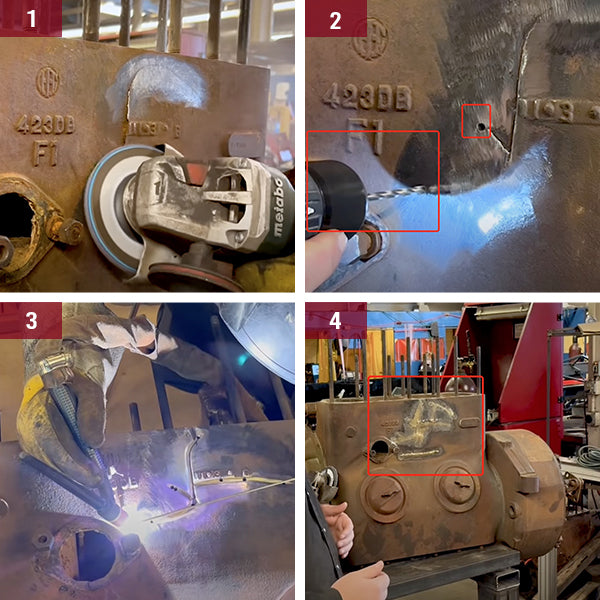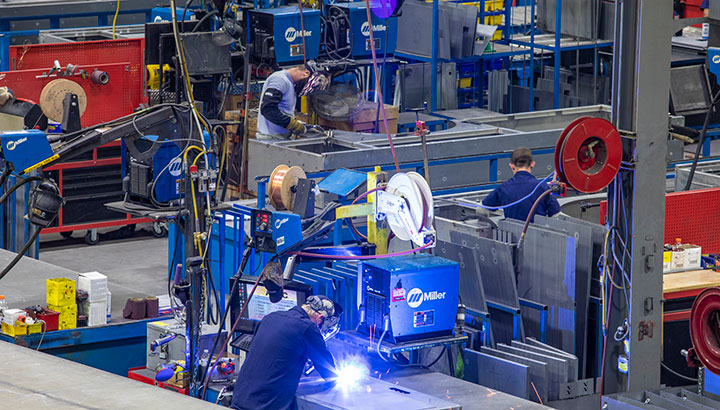Usual Welding Repair Issues and Just How to Address Them Efficiently
Welding repair work commonly run into an array of problems that can threaten the integrity of the final item. Usual troubles consist of inadequate penetration, porosity, and misalignment, to name a few. Each flaw offers special obstacles that need details approaches for resolution. Recognizing these problems is vital for welders intending to enhance their skills and end results. This conversation will certainly explore these usual welding fixing problems and reliable approaches to address them.
Insufficient Penetration
Poor penetration occurs when the weld metal falls short to totally fuse with the base material, resulting in weak joints and possible architectural failings. This problem usually stems from inadequate warm input, inaccurate electrode angle, or improper welding speed. Welders might experience inadequate penetration as a result of a miscalculation of the required parameters for a certain product thickness or kind. In addition, contamination on the base material's surface can impede efficient bonding, intensifying the problem. To resolve insufficient penetration, welders should ensure ideal setups on their tools and preserve a tidy job surface. Regular assessment of welds is recommended to recognize any type of shortages early, enabling prompt modifications and the avoidance of jeopardized structural integrity in welded assemblies.
Porosity
Porosity is an usual defect in bonded joints that materializes as tiny gas bubbles trapped within the weld metal. This problem can compromise the honesty of the weld, bring about decreased stamina and potential failure under stress. Belgrade. Porosity typically emerges from contamination, wetness, or improper welding techniques, which enable gases to escape into the liquified weld swimming pool. To resolve porosity, welders should ensure proper surface preparation, maintain a tidy working atmosphere, and use suitable welding parameters. Furthermore, selecting the appropriate filler material and protecting gas can minimize gas entrapment. Normal assessment and testing of welds can aid identify porosity early, guaranteeing prompt restorative activities are taken, consequently protecting the top quality and integrity of the welded structure
Misalignment
Imbalance in welding can develop from different factors, consisting of incorrect configuration and thermal expansion. Comprehending the origin is crucial for efficient resolution. Several adjustment strategies are offered to straighten components and ensure structural stability.
Causes of Misalignment
Welding imbalance frequently comes from a variety of underlying problems that can jeopardize structural integrity. One primary cause is inappropriate fit-up of components before welding, which can cause spaces and unequal surfaces. Variants in thermal growth during the welding procedure can additionally lead to distortion, particularly if the materials being joined have different coefficients of development. Additionally, poor fixturing and securing may fail to hold parts securely in position, bring about movement throughout welding. Badly kept devices, including welding equipments and tools, may present variances in the weld grain, more adding to imbalance. Finally, driver error, stemming from insufficient training or experience, can also play a significant duty in producing misaligned welds.
Correction Methods Offered
Resolving misalignment effectively calls for a mix of rehabilitative methods customized to the particular problems available. One typical technique is the use of jigs or components to hold components in the proper position during welding, guaranteeing constant alignment. Furthermore, preheating the products can assist decrease distortion and boost fit-up. For considerable imbalance, mechanical realignment methods, such as utilizing hydraulic jacks or clamps, can be utilized to fix the setting prior to welding. Post-weld heat treatment may also be essential to relieve stresses brought on by misalignment. Careful evaluation and adjustment throughout the setup stage can protect against imbalance concerns from ending up being considerable troubles, advertising a smoother welding procedure and enhancing general structural honesty.
Distortion
Distortion is a typical obstacle in welding that can develop from various elements, including irregular home heating and cooling. Recognizing the reasons for distortion is important for applying effective avoidance techniques. Resolving this problem not only enhances structural integrity however additionally enhances the general high quality of the weld.
Reasons of Distortion
When subjected to the extreme heat of welding, products frequently undertake changes that can cause distortion. This sensation mostly develops from thermal growth and contraction throughout the welding procedure. As the weld location warms up, the product expands; upon cooling, it contracts, which can develop inner stress and anxieties. Additionally, uneven home heating across a workpiece can worsen these anxieties, resulting in warping or flexing. The kind of material also plays a significant duty; metals with varying thermal conductivity and coefficients of growth may react differently, bring about uncertain distortions. Bad joint design and inadequate fixturing can add to misalignment throughout welding, raising the probability of distortion. Comprehending these causes is essential for efficient welding repair service and avoidance approaches.
Prevention Techniques
Efficient avoidance methods for distortion throughout welding focus on regulating warm input and these details making certain appropriate joint style. Maintaining a regular warm input assists to lessen thermal expansion and contraction, which can cause distortion. Utilizing techniques such as pre-heating the workpiece can additionally lower the temperature slope, promoting consistent heating. Additionally, picking suitable joint layouts, such as T-joints or lap joints, can improve stability and lower stress and anxiety focus. Implementing proper fixturing to safeguard the workpieces in position additionally aids in keeping positioning during the website here welding process. Finally, staggered welding series can distribute warmth a lot more equally, preventing localized distortion. By applying these methods, welders can greatly decrease the likelihood of distortion and enhance the total quality of their welds.
Breaking
Cracking is a typical concern come across in welding fixings, commonly arising from different elements such as improper air conditioning prices, product selection, or inadequate joint prep work. The occurrence of splits can greatly compromise the honesty of the weld, causing potential failures during operation. To resolve this concern, welders need to first analyze the root triggers, guaranteeing that materials work and properly chosen for the specific application. Furthermore, regulating the cooling price throughout the welding procedure is crucial; quick air conditioning can generate stress and result in breaking. Proper joint design and prep work also add to decreasing the danger. Implementing these methods can improve weld high quality and sturdiness, eventually decreasing the possibility of cracking in ended up weldments.

Incomplete Fusion
A significant issue in welding fixings is incomplete fusion, which occurs when the weld steel does not effectively bond with the base material or previous weld passes - Fabrication. This defect can lead to weak points in the joint, potentially compromising the stability of the welded structure. Variables adding to incomplete combination consist of not enough warm input, inappropriate welding method, and contamination of the surfaces being joined. To resolve this problem successfully, welders need to guarantee appropriate pre-weld cleansing and surface area preparation, along with readjust their welding parameters to accomplish appropriate infiltration and blend. Regular examination during the welding procedure can additionally aid determine incomplete fusion early, enabling prompt corrective measures to enhance the total quality of the weld
Overheating
While welding repairs can improve architectural honesty, overheating presents a significant challenge that can cause material deterioration. Too much warmth during welding can change the mechanical buildings of metals, resulting in decreased stamina, enhanced brittleness, and warping. This phenomenon is especially crucial in high-stress applications where structural dependability is paramount. Determining getting too hot can entail aesthetic examinations for staining or distortion, as well as monitoring temperature throughout the welding procedure. To mitigate the risks associated with getting too hot, welders should employ proper strategies, such as regulating heat input, changing travel speed, and using suitable filler materials. In addition, implementing pre- and post-weld warmth treatments can help recover material properties and enhance the overall high quality of the repair work, guaranteeing lasting efficiency and safety and security.
Regularly Asked Inquiries
What Are the Common Indications of a Welding Problem?

How Can I Check My Welds for Quality?
To evaluate welds for quality, one can utilize visual examinations, ultrasonic testing, and radiographic methods. Each method assures architectural stability, identifies visit the site issues, and validates adherence to defined standards, ultimately enhancing the dependability of the welded joints.
What Security Preventative Measures Should I Take While Welding?
When welding, one should prioritize safety and security by putting on suitable personal protective devices, making sure correct air flow, safeguarding combustible materials away, maintaining a tidy work space, and being aware of surroundings to avoid injuries and mishaps.
Can I Fix a Weld Without Renovating the Entire Joint?
Repairing a weld without remodeling the whole joint is feasible, relying on the damage (Montana Mobile Welding and Repair Welding). Techniques such as grinding, adding filler product, or using a welding procedure can successfully address certain flaws while maintaining the surrounding framework
What Equipment Are Necessary for Efficient Welding Services?
Essential devices for reliable welding repairs consist of a welding maker, wire brush, mill, protective equipment, clamps, and filler products. Each device plays a vital duty in ensuring high quality and safety during the repair service procedure. Porosity commonly emerges from contamination, dampness, or inappropriate welding methods, which permit gases to leave into the liquified weld swimming pool. Badly conserved equipment, consisting of welding machines and devices, might present inconsistencies in the weld bead, more adding to imbalance. When subjected to the extreme heat of welding, products usually go through modifications that can lead to distortion. Breaking is a typical problem encountered in welding repair work, often resulting from different factors such as incorrect air conditioning prices, material option, or inadequate joint preparation. A substantial concern in welding repairs is incomplete blend, which occurs when the weld metal does not appropriately bond with the base material or previous weld passes.